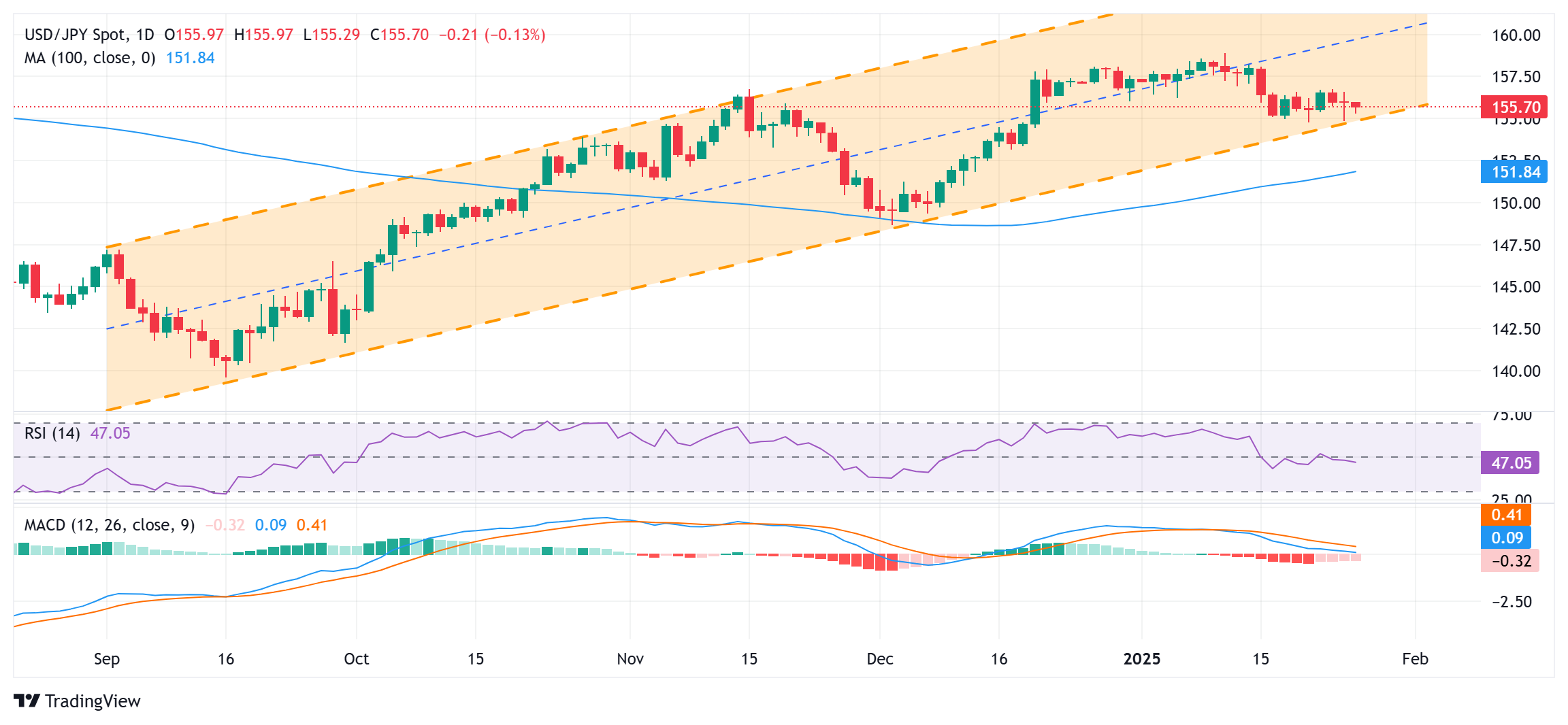- Japanese Yen attracts some safe-haven flows amid renewed trade war fears.
- The BoJ’s hawkish rate hike on Friday appears to further support the JPY.
- The narrowing of the yield differential between the US and Japan lends additional support to the JPY.
The Japanese Yen (JPY) begins the new week on a positive note amid the global flight to safety, driven by renewed trade war fears and the Bank of Japan’s (BoJ) hawkish interest rate hike on Friday. Furthermore, hopes that the spring wage negotiations will result in strong increases again this year and allow the BoJ to tighten its policy further turn out to be another factor supporting the JPY. This, in turn, dragged the USD/JPY pair below the mid-155.00 zone during the Asian session and closer to a one-month low, although a modest rally in the US Dollar (USD) could help limit losses. .
Meanwhile, bets that the Federal Reserve (Fed) will cut borrowing costs twice this year, fueled by US President Donald Trump’s call to lower interest rates, trigger a new decline in US Treasury yields. The resulting narrowing of the US-Japan yield differential supports prospects for a further appreciation move for the lower-yielding JPY, suggesting that the path of lower resistance for the torque USD/JPY remains bearish. Traders now await US macroeconomic data to take advantage of short-term opportunities later during the early North American session.
The Japanese Yen receives support from a combination of factors
- US President Donald Trump imposed 25% tariffs on all imports from Colombia after the latter refused to allow two US military planes carrying deported migrants to land in the country.
- Trump warned that tariffs will rise to 50% next week in the event of further defaults, fueling trade war concerns and increasing demand for the traditional safe haven, the Japanese yen.
- The anti-risk flow, along with the Federal Reserve’s rate cut bets, drags US Treasury yields lower, narrowing the yield differential between the US and Japan and lending additional support to the JPY.
- The Bank of Japan decided to raise interest rates by 25 basis points, the largest rate hike since February 2007, from 0.25% to 0.50%, or the highest level since the 2008 global financial crisis.
- The BoJ reiterated that it will continue to raise the policy rate and adjust the degree of monetary accommodation if the outlook presented at the January policy meeting is realized.
- The BoJ does not expect consumer inflation to fall below its 2% target any time soon and forecasts slower growth, although it noted rising wages could drive a ‘virtuous circle’ of growth.
- Data released on Friday showed Japan’s core consumer inflation accelerated to the fastest annual pace in 16 months during December, pointing to expanding inflationary pressure.
- Annual spring wage negotiations have begun in Japan, with leaders of the main business lobby and labor unions agreeing on the need to maintain momentum for wage increases.
- Traders now look forward to Monday’s US economic docket, which includes durable goods orders, the Conference Board consumer confidence index and the Richmond manufacturing index.
USD/JPY Bears Await Break Below Multi-Month Ascending Channel Support
From a technical perspective, any subsequent decline could continue to find support near the lower boundary of a multi-month ascending channel, currently situated near the 155.25 region. This is closely followed by the psychological level of 155.00 and the support of 154.80-154.75, which if broken decisively will be considered a new trigger for the bears. Since the oscillators on the daily chart have just started to gain negative traction, the USD/JPY pair could then accelerate the decline towards the round figure of 154.00 en route towards the mid-153.00 zone and the 153.00 level.
On the other hand, any recovery attempt could now face some resistance near the 156.00 level. The next relevant hurdle is located near the 156.75 supply zone. Some follow-through buying, leading to subsequent strength beyond the 157.00 level, should pave the way for a move towards the 157.55 area en route towards the 158.00 level. USD/JPY could eventually rise to the 158.35-158.40 region before aiming to retest the multi-month peak, around the 159.00 neighborhood touched on January 10.
Japanese Yen FAQs
The Japanese Yen (JPY) is one of the most traded currencies in the world. Its value is determined broadly by the performance of the Japanese economy, but more specifically by the policy of the Bank of Japan, the differential between the yields of Japanese and US bonds or the risk sentiment among traders, among other factors.
One of the mandates of the Bank of Japan is currency control, so its movements are key for the Yen. The BoJ has intervened directly in currency markets on occasion, usually to lower the value of the Yen, although it often refrains from doing so due to the political concerns of its major trading partners. The BoJ’s current ultra-loose monetary policy, based on massive stimulus to the economy, has caused the depreciation of the Yen against its main currency pairs. This process has been exacerbated more recently by a growing policy divergence between the Bank of Japan and other major central banks, which have opted to sharply raise interest rates to combat decades-old levels of inflation.
The Bank of Japan’s ultra-loose monetary policy stance has led to increased policy divergence with other central banks, particularly the US Federal Reserve. This favors the widening of the spread between US and Japanese 10-year bonds, which favors the Dollar against the Yen.
The Japanese Yen is often considered a safe haven investment. This means that in times of market stress, investors are more likely to put their money in the Japanese currency due to its supposed reliability and stability. In turbulent times, the Yen is likely to appreciate against other currencies that are considered riskier to invest in.
Source: Fx Street
I am Joshua Winder, a senior-level journalist and editor at World Stock Market. I specialize in covering news related to the stock market and economic trends. With more than 8 years of experience in this field, I have become an expert in financial reporting.








